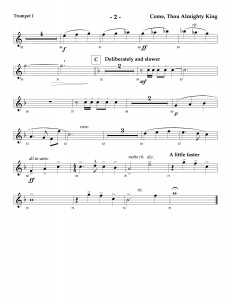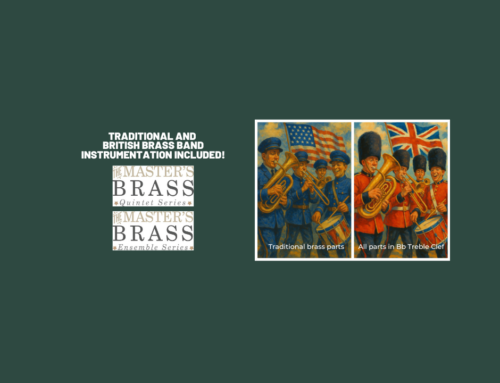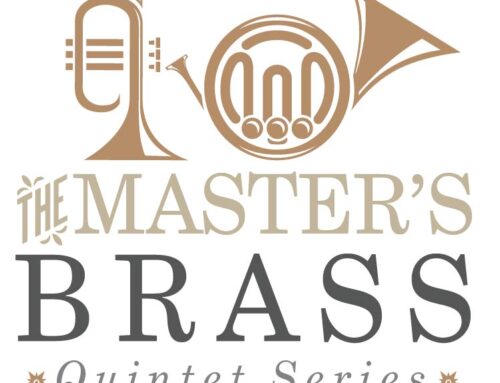When school starts back up for the Fall in just a few weeks, I will have been playing trumpet for 30 years of my 42 years on this planet. According to one of the algebraic equations I remember from my youth, that means I have been playing trumpet for about 71% of my life.
I have had some amazing opportunities in my life of trumpet playing so far. I’ve had the opportunity to tour professionally with the group TRUTH back in the 90s sitting next to one of my dear friends and first call trumpet player here in Nashville, Steve Patrick. I played trumpet on a CD with Jody Benson (Ariel-The Little Mermaid). I’ve played (and gotten paid) to play in a symphony, in a number of musicals, wedding receptions, numerous times in recording sessions, a touring big band out of Nashville and tons of college big bands, marching bands, wind ensembles and brass ensembles.
There have been a LOT of great memories playing trumpet.And…well…there have been a number of not so great memories playing trumpet.
1. When I play solos in church, I typically go for more mellow, flugelhorn type solos. I tend to stay away from flashy, fanfare type things generally speaking. I decided once to play Bugler’s Holiday in church as a solo (this is a trumpet trio AND should STAY a trumpet trio by the way). I thought I’d ‘show off’ a little, play some fast double tonguing and wow the folks. Not really the best attitude and well….I start it off too slow, so the double tonguing is just too slow to double tongue and slightly too fast to single tongue so it was in a weird middle spot. I get to the end of the song. There’s a little fanfare triplet thing that ends on a High C. Not a big deal, but I took it too slow, there weren’t any rests and well…I go for the high C 3 times (and miss every time-playing a Bb) and finally just end on a Low C and then try to casually walk/run off the stage in utter embarrassment.
2. I was playing in my college jazz band and had a trumpet solo feature on ‘I’ll Be Home for Christmas’. The jazz band was being featured live on the radio. We ran through the song in what I was thinking was sound check, but I was completely sure and because of that, I went ahead and played full on. The end of the song didn’t really have ANY breaks for the soloist so when I finished, I was pretty tired. Then, about 5 minutes later, we actually did it live. I was shot. Nada. Bupkus. So far, this recording hasn’t surfaced on YouTube and I’m grateful. I played ‘most’ of the notes but my tone was bad, I was out of tune and I just couldn’t make it through to the end. And on top of that there were spots where I hit a note, then the band, then I hit a note, then the band. Well…yeah. it was horrible. To this day, when I see/talk to the band director, that one moment comes to my mind.
Both of those moments are completely my fault. Full responsibility here. No question. I was going through some weird embouchure issues (and I later learn that my set-up was not great), but but but there is a similarity in both of the above ‘awesome’ (cough, cough) moments in my career.
Endurance.
Plain and simple.
Making it to the end of the song and finishing strong.
With my composing, arranging and orchestrating, I have the opportunity to write for all different sorts of groups. In the past 2 months, I have written for full orchestra, pro horn section, full big band, marching band and a wind ensemble/chorale group. When I am writing for ‘weekend warriors’ (folks that play on Sundays and rehearse on Wednesdays and that’s it), I really try to be mindful of how long I’m keeping the horns on their faces to try and help as much as possible for them to have a positive experience. Basically, I’d like them not to have a blog post like #1 and #2 above at some point in their life.
And there is one thing that I try to do when writing for brass players (trumpeters especially) that I think MANY arrangers do a pretty terrible job at when writing for ‘weekend warrior/volunteer’ type groups. And in all honesty, it’s a pretty simple fix.
GET THE HORN OFF THE FACE NEAR THE END OF THE SONG IF THEY ARE ENDING ON SOMETHING HIGH!!!!!
Sometimes, the idea of endurance isn’t just the one song they are playing, it’s the fact that they’ve played 4 songs before this AND it’s the 3rd service that morning AND they did a complete sound check before the first service. I know there are plenty of discussion points in regards to building chops, having additional players, and being able to handle the part you’ve been given. BUT one of the things I try to do when writing smaller ensemble pieces is be aware of the possible situations the players may be in and try to help them out. Whenever possible, I just try to give the lead trumpet a moment near the end to get the horn off the face. This is not one of those things where they need to rest for 12 bars before the last note. Not at all. You still have to be able to play. BUT, I like to give them options when possible. Here is a sample from our Master’s Brass Quintet Series that shows a couple of of ways that I like to try and ‘help out’ the lead trumpet.
(Disclaimer:I am NOT talking about studio musicians who play 6-9 hours a day or for monster players. I am talking about someone who’s picked up their horn after 20 years, is slowly getting his chops back and LOVES to play trumpet at church. I’m talking about folks who can get tired playing through 3 services on a Sunday morning)
 I’ll break down a couple ideas here:
I’ll break down a couple ideas here:
1. Top of the page (m. 46-51). This is not necessarily high for lead trumpeters. For some ‘weekend warriors’ however, it could be a little. And if they’ve been playing a bunch that morning, this could just take a little bit of effort. The 4 bars before that (m. 42) the 2nd trumpet is building up. So instead of both trumpets building, I have the 2nd trumpet build for 4 bars and then the 1st trumpet comes in.
2. Section C has a number of 2 measure rests throughout it. Couple reasons here. If this is the 5th song that Sunday and it’s the offertory special (this is a brass quintet arrangement), it is ‘possible’ that the lead trumpet could be a little tired. (or a lot!). So I’ve built in 2 bars, 2 bars, 1 bar, 2 bars and 3 bars rest before we get to the end of the song. This allows him time to get the horn off his face before the end of the song.
3. ‘all in unis.’ This has become one of my trademarked (not ® obviously) things I like to do when possible. The power of the trumpets in unison is GREAT! There’s one other benefit that happens. It’s a ‘just in case’ moment for the lead trumpet. We do this all the time at churches where I’m playing. If the lead guy is finding out that he’s getting a little tired, I like to give him a measure or so near the end where if he needs to, he could take the horn off the face. This is EXACTLY why m. 68-70 are written this way. If this is one of those days, like me in ‘I’ll Be Home for Christmas’ and my chops are funky, the lead trumpet can sit out for those 2 1/2 measures and let the other trumpets play those measures and simply come in when it goes to divisi. Yes, I know it’s more powerful with more trumpets, but if the lead guy needs the break, he can take it. If he doesn’t, GREAT!
4. A quarter rest. This doesn’t seem like a big deal to non brass players. BUT BUT BUT to brass players, this is a big deal. In measures 71 and 73, I put a quarter rest on beat 1. It’s a musical choice, sure. BUT it’s also a endurance/awareness choice. There are many arrangers who write for church orchestras who have no clue how much of a difference that one beat makes. They just don’t get it. I wish they did. It would help so much in volunteer groups. I was taught by some great trumpet teachers and they told me if I have a beat, get the horn off the face for the beat. I do that. It really does help. It just gets the blood flowing again and helps with endurance.
These are just a few of the things that I try to do when writing for brass players to help them have positive and #winning (thank you Mr. Sheen) moments in church. I am NOT talking about when I’m writing for professional studio musicians for a big band, film score or symphony. But, I do at least think about the brass when I’m writing for those groups. I won’t give this many opportunities for the brass (this is an extreme example with a lot of ‘outs’) in the studio, but I will be thinking about how tired they may be near the end of the cue or the track. That keeps their chops more fresh and we get to do fewer takes and that saves money.
I wish that those folks who write for church orchestras with volunteer players would realize how much of a difference simply giving the brass guys a chance to get the horn off the face would make in the playing of their arrangements.
If one less trumpeter in the world doesn’t have a huge list of ‘humbling’ experiences in church, then this is worth it.
#givetheleadtrumpetplayerabreak
This arrangement sample taken from The Master’s Brass Quintet Series, Volume 7






Great article! Never thought much about giving the lead a breather before the end. Makes sense to me now. Best, Shane
This is so true. For music ministers it would also mean less re-arranging in order to support volunteer players. Hiring professional brass players is not the answer when volunteer players need a place to offer their skills in worship.
Good word, Jeff!